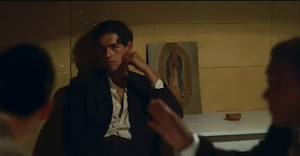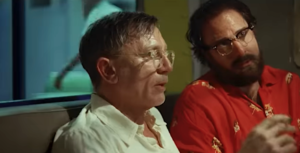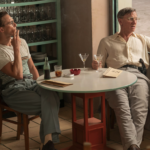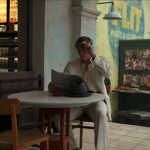By Robert St. Martin & Valerie Milano
Los Angeles, CA (The Hollywood Times) 1/4/25 – Luca Guadagnino’s adaptation of William S. Burroughs’ second novel, Queer is about a gay, drug-addicted American expatriate writer played by Daniel Craig in in Mexico City circa 1954. The film Queer is inspired by Williams S. Burroughs’ same-named, somewhat autobiographical novel, which was written in the mid-1950s as an extension of his controversial Junkie but was more or less abandoned by its author after Junkie was censored by its publisher. The latter was finally issued in an unexpurgated version (and retitled Junky, with a “y”) in 1977. At that point, post-counterculture and deep into 1970’s malaise, the public more amenable to its descriptions of drug use and same-sex trysts.

There is no question that Guadagnino is playing his hand with one of filmmaking heroes, Rainer Werner Fassbinder. Mixing period accurate sets and costumes, old-school production techniques (including rear projections and miniature buildings and landscapes) and deliberately anachronistic music choices (including snatches of songs by Nirvana), Queer often suggests a 1980s art house import by an outlaw filmmaker that was just recently rediscovered and suddenly a midnight cult favorite. It also serves up a smorgasbord of explicit homoerotic imagery, surrealism and ambiguity at a time when Western culture was stampeding towards 1950s prurience, literal-mindedness, and corporate “clean” images of the American lifestyle.
Daniel Craig with his bruiser face and odd glasses wanders drunkenly around a fever-dream vision of Mexico City created on the backlots of Rome’s Cinecittà Studios. The sheer homoerotic artifice on display is clearly tuned into Fassbinder’s Querelle, with even the driblets of sweat on people’s bodies are beguilingly overdone. Craig’s performance matches Guadagnino’s vision of Lee’s character. The film recalls the pathetically degraded boytoy from the 1998 Francis Bacon faux-biopic Love Is the Devil, as he labors to convey Lee’s destructive infatuation with the opaque, icily handsome Eugene Atherton (played by Drew Starkey).
 Eugene Atherton is based on Burroughs’ actual acquaintance and object of obsession Adelbert Lewis Marker. Though when the novel was finally published in 1985 (it was written between 1951 and 1953), the author himself noted in his introduction that his doomed wife, Joan Vollner, was the spirit animating much of its themes and characters. Even this should be taken with a healthy grain of salt given the Beat tendency toward serpentine self-mythologizing. Guadagnino nonetheless adopts the Joan-as-tragic-muse legend as gospel and recalls a similar aspect of David Cronenberg’s Naked Lunch.
Eugene Atherton is based on Burroughs’ actual acquaintance and object of obsession Adelbert Lewis Marker. Though when the novel was finally published in 1985 (it was written between 1951 and 1953), the author himself noted in his introduction that his doomed wife, Joan Vollner, was the spirit animating much of its themes and characters. Even this should be taken with a healthy grain of salt given the Beat tendency toward serpentine self-mythologizing. Guadagnino nonetheless adopts the Joan-as-tragic-muse legend as gospel and recalls a similar aspect of David Cronenberg’s Naked Lunch.
Divided into three chapters and an epilogue, Queer is at its best in its early scenes in the screenplay by Justin Kuritzkes (who wrote the screenplay for Guadagnino’s Challengers). Guadagnino sketches in the American Lee’s abashed existence as an expatriate alongside his good friend Joe (Jason Schwartzman, channeling Allen Ginsberg) and a gaggle of catty homosexuals led by queen-about-town John Dumé, played with gusto by Drew Droege (of Chloë Sevigny drag fame). Lee always seems to be covering up some guilty compulsion or overcompensating in his attempts at seduction. For Lee the character, it is easier to pay sex workers or shoot up heroin than to forge real human connection. Indeed, one of the most effective sequences here, captured in a single discomfiting shot, sees Lee prepare a syringe, inject himself, and then wait, with increasing desperation (and to the anachronistic, though poignant, accompaniment of New Order’s “Leave Me Alone”), for some kind of relief.

There really isn’t much of a plot. We are offered a loose accumulation of incidents that ultimately add up to a kind of story. It’s one that happens mainly internally: Mostly to Bill Lee, as he tries to first figure out whether Eugene is gay, and if so, whether he’s figured it out and/or acts out, openly or privately. Eugene gives Bill what seem like unambiguous looks of interest, sometimes accentuated by languorous slow-motion, only to walk past Bill in the local bistro and then spend all his time with a woman who might or might not be his girlfriend while casting glances at Bill that seem to last longer than casual glances but might mean a lot of things. The glacially gradual and chaste courtship between the two men, practically a slow dance that leaves Bill adrift in deniability, forms much of the film’s first section. They do eventually hook up with an extended, real-time enactment of physical passion. The chemistry is off, and that extends beyond the fictional realm. Craig and Starkey rarely click as performers. In their erotic encounters, especially, they seem like mere vessels for Guadagnino.
Lee and Eugene’s lack of magnetism is especially grating when they travel together in search of a drug called yage (or ayahuasca) in jungles of Peru. Lee is convinced will open up telepathic doors of perception and connection. It’s here that Queer most deviates from Burroughs’s text, contriving a tonally bizarre climactic interlude involving a mad botanist, Dr. Cotter (an over-the-top Lesley Manville) accompanied by her mute husband played by Argentine director Lisandro Alonso.

Queer becomes a sort of foolish love story that grows increasingly destructive (for Eugene) and self-destructive (for Bill, though he’s a destroyer as well). As their relationship progresses, Eugene seems increasingly disgusted with himself for having gotten into this predicament, though he avoids stating what our eyes can plainly see. Bill, too, seems to know what a disaster they’re in, and starts to try to hold onto Eugene just so he won’t have to deal with having lost him.
The film feels dislocated stylistically and temporally as well as geographically. The knowingly modern touches and frequent, almost Brechtian distancing devices in Guadagnino’s adaptation (including an extended jungle sequence that was either shot entirely in a studio or lit to look as if it was) mark Queer as the product of a contemporary consciousness, by an artist who speaks fluent Internet and can direct in meme-able images. The ending of the film is vaguely Lynchian with the aged William Lee in an eerily empty room, that seems to evoke Visconti’s Death in Venice as the strands of Lee’s life interweave with Burroughs’s own.









